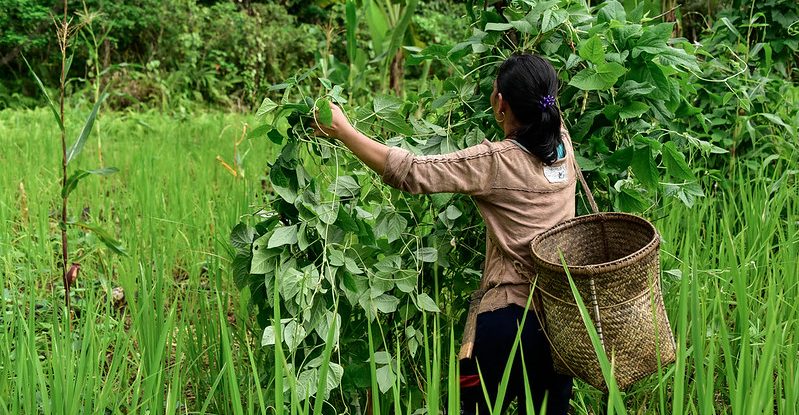Trees on or around farms can improve soil health, regulate microclimates, enhance carbon sequestration, and improve biodiversity at multiple scales. However, the ways in which tree-based farming systems affect the diets of rural populations is less well understood.
Today we are producing more food than ever before in history, and yet malnutrition is still the leading cause of poor health globally – a problem that has only been exacerbated by the recent COVID-19 pandemic.
Although technological advances in industrial agriculture have decreased global hunger in recent decades, the increase in food production has not necessarily resulted in healthier diets. In fact, agricultural expansion has increased global dependence on maize, rice and wheat, which are rich in calories but relatively low in micronutrients. Although humans can eat about 7,000 different plants for food, these three staple crops account for 50 percent of plant-based food intake.
Smallholder farmers in low-and middle-income countries produce much of the world’s food, yet these farming households also disproportionately suffer from poor diets. Food security and nutrition policies in these regions often focus on increasing agricultural production, either through intensification of existing production systems or expansion of cultivated land at the expense of forests and other biodiverse ecosystems. Yet, wild foods from forests and fallows can be an important source of micronutrients for smallholder farmers in these regions.
Although far from a new farming technology, researchers and policymakers are increasingly considering the integration of trees on and around farming systems as a potential “win-win” solution for supporting dietary quality and the natural environment. The evidence on associations between tree-based farming systems and positive ecological outcomes is well documented: trees on or around farms can improve soil health, regulate microclimates, enhance carbon sequestration and improve biodiversity at multiple scales.
However, the ways in which tree-based farming systems affect the diets of rural populations is less well understood.
To contribute to this developing field, a team of researchers from Denmark’s University of Copenhagen and the Center for International Forestry Research and World Agroforestry (CIFOR-ICRAF) reviewed papers that assess the dietary quality of populations practicing tree-based farming in low- and middle-income countries.
The researchers identified 36 papers that together highlight three distinct pathways through which trees on or around farms support people’s diets:
- Providing edible products such as fruits, nuts, and leaves – the most direct link
- Providing marketable products, where people can use the money to buy food – the indirect income link
- Improving agricultural production of other crops through ecosystem services (e.g. increased pollination, microclimate regulation), where people either consume or sell the additional harvest – the indirect agroecological link
Taken together, most of the reviewed studies indicate positive associations between tree-based farming systems, household income and improved dietary quality. Yet, the relative benefits for income and diet quality depend on the type of tree-based farming system in place: (a) home gardens/trees on farms; (b) shifting cultivation systems; (c) timber/plantation tree crops or (d) forest-edge farming.
In general, the studies show that maintaining diversity within tree-based farming systems can provide households with more means to diversify their diets with foods from the farm and market. Additionally, preserving biodiversity within and around tree-based farming systems may also increase the availability of micronutrient-rich foods in the wild. Finally, the cultivation of multiple tree species can serve as important safety net for households in the face of uncertain climatic or economic conditions, improving access to nutritious foods year-round.
The types of species and arrangement of trees within different farming systems could be another important factor that affects the benefits for diets. However, from the small number of studies published to date, it was not possible to identify which types of tree-based farming system configurations are best for improving dietary quality.
A further development of tree-based farming system classifications with a distinct consideration of food (i.e. home gardens or trees on farm, shifting cultivation, timber or plantation tree crops, and forest-edge farming) could be a first step to making better empirical comparisons across disparate cultural and geographical contexts.
The extent to which any tree-based farming system can influence diets also depends on factors outside the farming system itself. Policies and institutions at the national scale, bioclimatic and geographical aspects at the landscape scale, as well as socioeconomic aspects at both the landscape and household level, such as market access, education, and/or gender-driven power dynamics play an important role in determining how tree-based farming affects household diets.
These various influences are difficult to tease apart and have yet to be thoroughly investigated.
While a general positive association is found, the synthesis highlights the complexity of drawing links between trees, farming systems, and dietary quality.
Improved visibility and understanding of the role that trees play in promoting more ecologically sustainable and nutritious diets is key to designing more sustainable landscapes for people and the planet.
We want you to share Forests News content, which is licensed under Creative Commons Attribution-NonCommercial-ShareAlike 4.0 International (CC BY-NC-SA 4.0). This means you are free to redistribute our material for non-commercial purposes. All we ask is that you give Forests News appropriate credit and link to the original Forests News content, indicate if changes were made, and distribute your contributions under the same Creative Commons license. You must notify Forests News if you repost, reprint or reuse our materials by contacting forestsnews@cifor-icraf.org.
